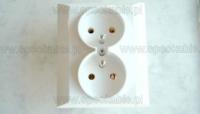kamo_83 wrote: I warmly welcome! he writes right away that I am a complete layman in the field of electricity, but I have encountered such a problem, maybe someone will help me .. by installing a fluorescent lamp with Osram's electronic ballast, I have written on the L and N inputs since the current is alternating (I know), why differentiate on L and N what will happen if I connect the other way? can someone explain it to me?
Thank you very much to all professionals for their understanding ..

Because, despite the alternation of current, the phase, i.e. L, is directly connected to the voltage source - the transformer winding.
N - that is, zero, is connected to the transformer neutral point.
This means that on the L, while the current is not flowing, you have a constantly dangerous potential - in short.
On N, this potential is much lower.
Therefore, the manufacturer means where you should connect the wires, because some home-grown neon lamp expert would give the phase to the housing and hurt someone.
And when he does it, and the sex flows, it will not make any difference to the connected person whether the current changes and from which side ...





